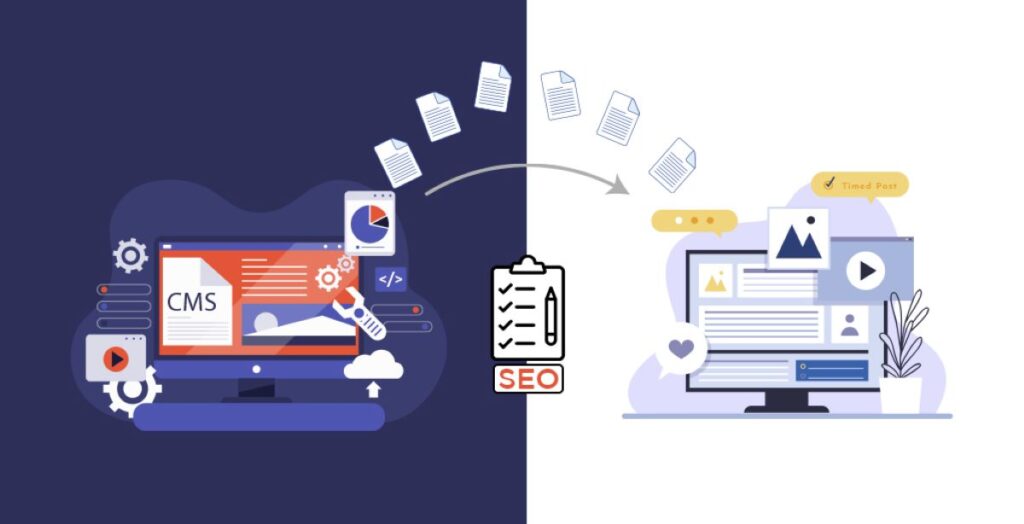What is the Best CMS for Customisation and ROI: Umbraco or Sitecore?
Umbraco and Sitecore are two leading content management systems (CMS) in the Microsoft .NET ecosystem, each catering to different business needs. Umbraco is an open-source platform known for its flexibility and cost-effectiveness, while Sitecore is an enterprise-level digital experience platform with advanced marketing features.
Choosing the right CMS in the Umbraco vs Sitecore debate depends on two key factors: customisation potential and return on investment (ROI). Businesses need platforms that can adapt to their specific workflows, integrate smoothly with existing systems, and provide measurable value without high implementation costs or technical obstacles.
This comparison of Umbraco and Sitecore looks at how these two CMS platforms stack up in terms of customisation options, integration capabilities, deployment efficiency, and pricing structures. Whether you’re a growing business looking for agile solutions or an enterprise requiring powerful marketing automation, understanding the strengths of these platforms will help you determine which one offers better ROI for your particular needs. The analysis also covers practical aspects such as licensing models, technical complexity, and real-world implementation timelines that directly affect your bottom line.
What Are the Key Features of Umbraco and Sitecore?
Umbraco is an open-source .NET-based CMS that prioritises flexibility and cost-effectiveness. Built on the Microsoft framework, it delivers essential content management capabilities including SEO optimisation, multilingual publishing, and role-based access control. The platform supports both cloud and on-premise deployment, runs on Linux, and integrates seamlessly with composable DXP architectures. Its intuitive interface allows marketers and content editors to manage content without extensive technical training.
Sitecore operates as a commercial enterprise-grade DXP with comprehensive marketing automation tools. The platform includes integrated solutions for personalisation, customer data platforms (CDP), digital asset management (DAM), forms, email marketing, and e-commerce capabilities. Sitecore provides official support services, professional implementation assistance, and regular security updates designed for mission-critical enterprise operations.
The Umbraco overview positions it as ideal for small to medium-sized businesses requiring customisable solutions without significant upfront investment. The Sitecore overview reveals its strength in serving large enterprises that demand scalability, robust marketing features, and the ability to handle high-traffic loads efficiently across multiple channels and touchpoints.
How Do Umbraco and Sitecore Differ in Customisation Capabilities?
Umbraco’s open-source model grants developers complete access to source code, enabling unlimited CMS customisation without restrictions or vendor lock-in. Businesses can modify core functionality, create bespoke features, and adapt the platform precisely to their workflows without paying additional licensing fees for custom development.
The active developer community surrounding Umbraco significantly enhances its flexibility. Thousands of contributors maintain packages, plugins, and extensions that businesses can leverage for rapid customisation. This collaborative ecosystem means solutions to common challenges already exist, reducing development time and costs whilst maintaining the option for proprietary modifications.
Sitecore delivers extensive out-of-the-box features including personalisation engines, analytics dashboards, and marketing automation tools. These pre-built capabilities reduce initial development requirements for standard enterprise functions. The trade-off comes in customisation complexity—modifying Sitecore’s architecture demands specialised technical expertise and deeper understanding of its proprietary framework. Businesses face higher barriers when tailoring the platform beyond its intended design, often requiring certified developers familiar with Sitecore’s specific architecture patterns. This commercial CMS approach prioritises comprehensive functionality over modification freedom.
Which Platform Offers Better Integration Options?
Umbraco excels at connecting with third-party systems through its flexible architecture. The platform seamlessly integrates with popular e-commerce platforms, CRM systems, and analytics tools without requiring proprietary solutions. This approach supports modern composable digital experience platform (DXP) architectures, allowing businesses to select best-of-breed tools that match their specific requirements.
Key integration advantages of Umbraco:
- Native API support for connecting external services
- Freedom to choose specialized tools for marketing, commerce, and data management
- Lower integration costs through open-source connectors
- Faster implementation timelines for multi-system environments
Sitecore takes a different approach by providing comprehensive built-in tools including Customer Data Platform (CDP), Digital Asset Management (DAM), and email marketing capabilities. These integrated solutions eliminate the need for multiple external vendors, creating a unified ecosystem. The trade-off involves navigating Sitecore’s complex architecture, which demands specialized technical knowledge to configure and maintain these interconnected systems effectively. Businesses must weigh the convenience of an all-in-one solution against the flexibility of choosing independent tools.
How Do Deployment and Usability Compare Between Umbraco and Sitecore?
Deployment
Umbraco offers flexible deployment options with both cloud and on-premise hosting available. This allows businesses to choose based on their infrastructure preferences and security requirements. Projects typically go live within 4 months, which is significantly faster than enterprise alternatives. This quicker timeline is due to Umbraco’s streamlined architecture and straightforward configuration process.
On the other hand, Sitecore’s deployment requires considerably more time and resources because of its complex architecture and extensive feature set. Implementation projects often take longer than 6-8 months as teams set up multiple integrated modules.
Usability
Umbraco stands out in terms of user interface usability with its intuitive content management dashboard. Content editors and marketers can easily navigate the system without needing extensive technical knowledge, resulting in minimal training requirements. The clean, modern interface allows teams to publish content, manage media assets, and update pages with little onboarding.
In contrast, Sitecore has a steeper learning curve due to its sophisticated capabilities. Content editors, developers, and administrators need dedicated training programmes to fully understand the platform. Organisations using Sitecore must also invest in comprehensive documentation and ongoing support to ensure team productivity across its advanced marketing automation and personalisation tools.

What Are the Cost Implications and ROI Differences?
Umbraco offers better value for money as a CMS because it has no licensing fees and takes an average of 4 months to implement. This means businesses can expect to see a return on their investment within the first year. The open-source model also allows for complete customisation, making it an appealing choice for organisations with limited budgets.
On the other hand, Sitecore requires a significant upfront investment due to high annual licensing fees that can reach six figures. It also has longer deployment periods, often taking 6-9 months or more. The overall cost of ownership includes the need for dedicated technical teams to maintain and customise the platform because of its complexity.
The way ROI is calculated varies greatly between the two platforms:
- Umbraco: Lower initial investment + faster implementation = quicker return on investment
- Sitecore: Higher licensing costs + longer deployment = delayed but potentially greater long-term value for large enterprises
Businesses need to consider both immediate cost savings and long-term capabilities. Umbraco’s streamlined approach is ideal for organisations that prioritise getting to market quickly and being efficient with their budget. On the other hand, Sitecore’s extensive features justify its higher price tag for enterprises that require advanced marketing automation and scalability at an enterprise level. You may like to visit https://astralwebspace.com/umbraco-consulting-when-should-you-hire-an-expert-for-complex-cms-projects/ to get when should you hire an expert for complex CMS projects?
For Which Business Types Is Each CMS Best Suited?
Umbraco serves small to medium-sized businesses that need customisable yet affordable SMB CMS solutions with rapid deployment. Companies with limited budgets and smaller technical teams benefit from Umbraco’s intuitive interface and straightforward implementation, achieving market presence within 4 months. The platform suits organisations prioritising flexibility over extensive built-in marketing features, particularly those building composable DXP architectures by integrating best-of-breed third-party tools.
Sitecore targets large enterprises with complex digital ecosystems requiring enterprise CMS solutions at scale. Multinational corporations managing high-traffic websites across multiple regions leverage Sitecore’s robust infrastructure for performance optimisation under demanding loads. Organisations with dedicated IT departments and substantial budgets gain value from integrated marketing automation, personalisation engines, and customer data platforms. The platform addresses scalability needs for businesses processing millions of user interactions whilst maintaining consistent performance. Retail giants, financial institutions, and global brands with sophisticated marketing requirements represent Sitecore’s ideal customer profile, where the investment in licensing and implementation delivers proportional returns through advanced capabilities.

Conclusion
Choosing the right CMS involves honestly evaluating your organisation’s priorities. The business ROI CMS decision depends on four key factors: available budget, in-house technical skills, growth plans, and marketing needs.
Umbraco vs Sitecore Which CMS Offers Better Customisation and ROI for Businesses? The answer completely depends on your situation. Umbraco offers quicker returns on investment with lower costs and faster implementation, while Sitecore offers enterprise-level marketing capabilities for organisations with complex needs and large budgets.
Want to make a well-informed decision? Request personalised demos from both platforms and consult with certified implementation partners who know your industry. Assess actual customisation needs against estimated costs, and determine realistic timelines before making a commitment. Your CMS investment should align with both immediate requirements and three-year growth plans—choose the platform that supports your business trajectory, not just current needs.
FAQs About Choosing Between Umbraco and Sitecore for CMS Projects
Umbraco and Sitecore are content management systems (CMS) built on Microsoft’s .NET framework. Both help businesses manage digital content efficiently but serve different scales and requirements.
2. What makes Umbraco different from Sitecore?
Umbraco is open-source, lightweight, and highly customisable—ideal for small to mid-sized businesses. Sitecore is an enterprise-grade platform with built-in marketing automation and personalisation tools.
3. Which CMS offers better customisation options?
Umbraco offers complete freedom for developers to customise its source code, while Sitecore’s proprietary structure limits flexibility but provides extensive out-of-the-box features.
4. Which platform integrates more easily with other systems?
Umbraco integrates easily with third-party tools like CRM, analytics, and e-commerce systems through open APIs. Sitecore offers built-in marketing and data tools but requires more technical setup for external integrations.
5. How do deployment timelines compare?
Umbraco projects typically go live within 3–4 months due to simpler configuration. Sitecore implementations often take 6–9 months because of its complex, multi-module architecture.
6. Which CMS provides better ROI?
Umbraco delivers quicker ROI due to zero licensing costs and faster deployment. Sitecore provides long-term ROI for enterprises that can fully utilise its advanced features and marketing tools.
7. What are the key usability differences?
Umbraco features an intuitive, user-friendly dashboard suitable for non-technical editors. Sitecore requires dedicated training due to its sophisticated enterprise functionalities.
8. Which platform suits small businesses better?
Umbraco suits small to mid-sized businesses looking for affordable, flexible CMS solutions without long implementation cycles or high licensing costs.
9. Who should choose Sitecore instead?
Large enterprises with global websites, big budgets, and advanced marketing automation needs should choose Sitecore for its scalability and integrated digital experience capabilities.

